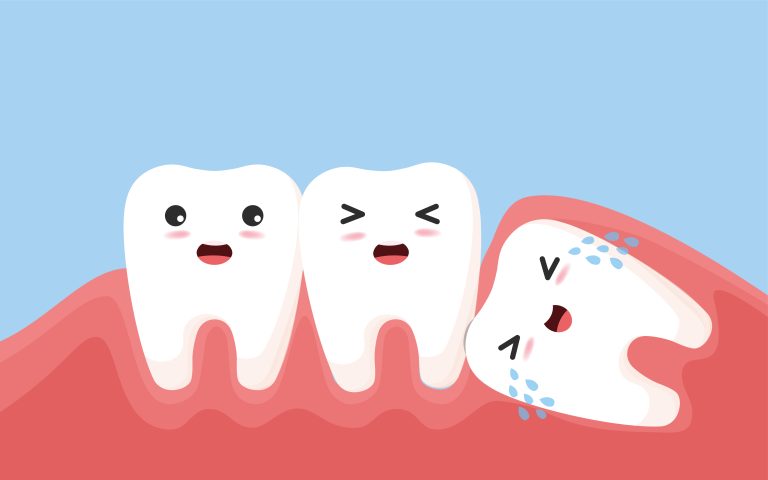
Wisdom teeth are the last teeth to erupt in your tooth row. They usually appear between the ages of 17 and 25, but some individuals may not experience them at all. They are located at the back of the mouth, and in most cases, they are the last to erupt. Although it is a natural process, the presence of wisdom teeth can often cause problems for some people.
For most individuals, wisdom teeth erupt without any issues. However, for others, they can cause pain, inflammation, and other problems such as teeth growing crooked or stuck under the gum. This condition can lead to various complications, sometimes requiring measures such as wisdom tooth extraction. This article will discuss more about wisdom teeth, signs of problems associated with them, and when you should consider seeking treatment or extraction.
Wisdom teeth usually come in without any problems, but sometimes they can cause difficulties. Watch for the following signs:
If you experience any of the following: unbearable pain, fever, swelling that gets worse, or signs of infection such as pus or a foul odor.
Not all wisdom teeth need to be removed. However, dentists will usually recommend surgery if the wisdom teeth are causing oral health problems. These include teeth that are stuck under the gums or growing in at an angle that is pressing on other teeth, causing recurring pain or gum infections, or leading to the formation of cavities (cavities) and gum disease because the area is difficult to clean.
In addition, wisdom teeth can also cause crowding of teeth or damage the structure of adjacent teeth. If this problem is left untreated, it can lead to more serious complications. Therefore, regular check-ups with your dentist are very important to determine whether your wisdom teeth need to be extracted or can be left untreated.

Before the procedure begins, the dentist will administer a local anesthetic to numb the area around the wisdom tooth and make it pain-free. In more complicated cases, general anesthesia may be used to keep you asleep throughout the procedure.
Once the area is numb, the dentist will begin the extraction. If the wisdom tooth is hidden in the gum, the dentist may need to make a small incision in the gum or split the tooth into several pieces to make the process easier. Special instruments are used to stabilize the tooth before it is carefully removed.
After the tooth is removed, the gum may be stitched to close the wound and speed healing. In the case of small wounds, stitches are not always necessary.
Before wisdom tooth extraction is performed, the dentist will conduct an initial examination to assess the condition of your teeth and mouth. This examination will help the dentist understand the position of the wisdom tooth and whether it is trapped in the gums or growing crookedly.
In addition to a physical examination, the dentist may take an X-ray to better understand the position of your wisdom tooth before the procedure begins, the root of the tooth, and the surrounding tissues. This allows the dentist to plan the extraction procedure more accurately and reduce the risk of complications.
Don’t hesitate to talk to your dentist about any concerns or anxieties you may have about the procedure. A clear explanation and better understanding of the procedure can help reduce any fear or anxiety.

After wisdom tooth extraction, proper care is very important to prevent infection and speed up recovery.
A little bleeding is normal. Bite on gauze for 30–45 minutes to stop the bleeding, and repeat if necessary. Swelling usually goes away in 1–2 days, while pain can be controlled with painkillers recommended by your dentist. On the first day, choose soft foods such as cold soup or yogurt, and avoid straws, hard foods, or hot drinks.
Apply an ice pack to your cheek for 15–20 minutes at a time, especially in the first 24 hours. Sleep with your head slightly elevated to reduce swelling. Avoid strenuous activity that may trigger rebleeding.
Contact your dentist immediately if the bleeding does not stop after a few hours, the pain or swelling gets worse after 2–3 days, you have a fever over 38°C, or the wound starts to ooze and smell.
Most dentists will schedule a follow-up a few days later to make sure the wound is healing properly. Use this session to ask about your recovery.
In conclusion, wisdom teeth can be problematic for some individuals, but with early attention and proper treatment, many complications can be avoided. If you experience symptoms such as pain, swelling, or difficulty opening your mouth, it is important to get checked out by a dentist immediately. Early action can help prevent more serious problems such as infection or damage to adjacent teeth.
It is important to have regular check-ups with your dentist, as this can identify wisdom tooth problems early and reduce the risk of future complications. After wisdom tooth extraction, make sure you maintain good oral hygiene to ensure the healing process goes smoothly. With proper prevention and care, you can overcome wisdom tooth problems more easily and comfortably.
Every smile deserves to feel comfortable. If wisdom tooth removal required, Hello Dental is ready to help you find the right solution. Gentle care can make a big difference, so you can move on with your life with more confidence.
Copyright © 2024 Hello Dental Clinic. All Right Reserved.
475, Jalan Sultan Azlan Shah,
Taman Million,
51200 Kuala Lumpur
Mon-Fri: 09:00-19:00
Sat-Sun: 09:00-17:00
V06-02-05, Signature Retail Lot,
Sunway Velocity,
Lingkaran SV, Jalan Shelley,
55100 Cheras KL
Mon-Fri: 09:30-21:00
Sat-Sun: 09:00-18:00
2-02, Level 2, Wisma Conlay,
No.1, Jalan USJ 10/1,
Taipan Business Centre,
47620 Subang Jaya, Selangor
Mon, Tue, Fri: 10:00-18:30
Wed, Thu: 10:00-21:00
Sat, Sun: 09:00-15:30
G-8, Idaman Robertson,
No. 2, Jalan Robertson,
50150, Kuala Lumpur.
Mon, Thur: 11:00-20:00
Tue, Wed, Fri: 09:30-21:00
Sat, Sun: 10:00-19:00
No. 2-2 (Second Floor),
Jalan Solaris 5,
Solaris Mont Kiara,
50480 Kuala Lumpur
Mon-Fri: 10:00-19:00
Sat-Sun: 10:00-18:00